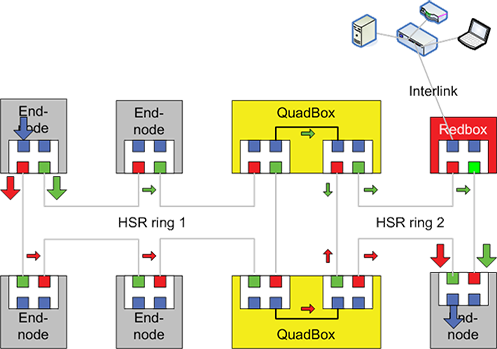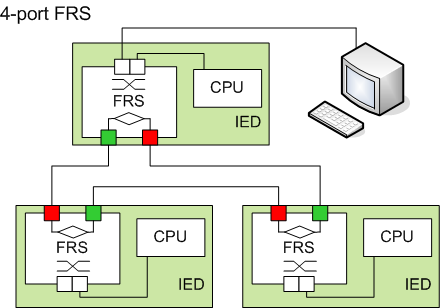Products
Technology
High-availability Seamless Redundancy (HSR)
Network downtime always generates unwanted costs, and in some applications network downtime is not acceptable at all, not even during maintenance. High-availability Seamless Redundancy (HSR) is a standard (IEC 62439-3 Clause 5) answering to the need for reliable Ethernet. It is suitable for applications that require short reaction times and high availability. With HSR, a network can be made very robust with zero reaction time in case of a single failure, with predictable latency and with less cost than with other Ethernet redundancy solutions.
Originally HSR was targeted at smart grid electrical substation automation, but it can also be employed in other critical networking applications, such as industrial automation, motion control and transportation.
The typical HSR topology is a ring. The source node duplicates all the frames it has to send, and sends them using two different paths to their destination. If either one of the paths is broken, due to link or node failure, the frames are still able to reach their destination.
Typically HSR rings consist of three kinds of nodes:
- End-nodes
- RedBoxes
- QuadBoxes
End-nodes have two external Ethernet ports to connect to one HSR ring. They may also have one or more additional Ethernet ports, for example for maintenance access. When sending frames, an End-node sends two duplicates of each frame into the network, one to each of the directions in the ring. When receiving, they accept the first copy and discard the second, thus eliminating the duplicate. Sensors such as IEDs (Intelligent Electronic Devices), cameras, and merging units in substation automation are examples of End-nodes.
RedBox (or Redundancy Box) is an entity that has three external Ethernet ports. Two of the ports are connected to an HSR ring and one port is a traditional Ethernet port. RedBoxes are used to connect non-HSR nodes and non-HSR network segments to HSR rings. This means, for example, ordinary Ethernet switches and computers. When forwarding frames to the ring, RedBox duplicates each frame and sends the two duplicates to the ring, one to both directions. When forwarding frames from the ring, RedBox forwards the first copy and removes the one that arrives later.
QuadBox or Quadruple Port Device is a device connecting two HSR rings to each other. As one QuadBox would itself be a single point of failure, two adjacent QuadBoxes are typically used between HSR rings.
Currently the HSR ring is perhaps the most effective high availability Ethernet method. HSR is similar to Parallel Redundancy Protocol (PRP) in sending duplicate packets, however, unlike in PRP, there is no need for duplicate cables or switches in ring topology. This makes an HSR ring much more cost effective than the two local area networks of PRP. Compared with Rapid Spanning Tree Protocol (RSTP), the benefit of HSR is its zero-time recovery – a single network fault in the ring will not result in any frame loss; the recovery times of RSTP are simply not acceptable in all applications.
Flexibilis Redundant Switch is our HSR implementation. One of its special features is that no separate RedBoxes are needed. Non-HSR nodes and segments can be connected straight to the HSR nodes and rings.
Although simple ring is the typical topology for HSR, it is not the only possible one. Other alternatives include for example Virtual QuadBox, ShortCut Box, ShortBox and HSR Mesh. All these are possible to implement with FRS. Please see the video for more information.



